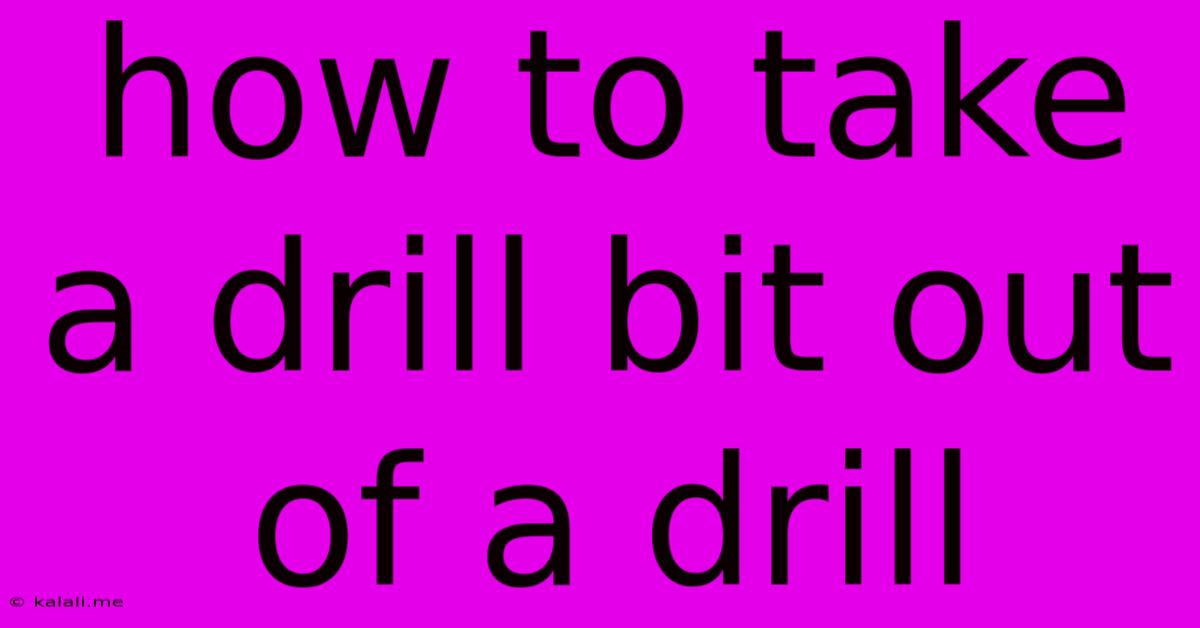How To Take A Drill Bit Out Of A Drill
Kalali
May 29, 2025 · 3 min read

Table of Contents
How to Remove a Stuck Drill Bit: A Comprehensive Guide
Removing a stuck drill bit can be frustrating, but with the right techniques, you can get it out without damaging your drill or yourself. This guide covers various methods for removing stubborn drill bits, from simple solutions to more advanced techniques. This article will cover everything from identifying the problem to preventing it in the future.
Why is my drill bit stuck?
Before jumping into solutions, let's understand why drill bits get stuck. Common causes include:
- Excessive force: Applying too much pressure while drilling can cause the bit to bind and seize.
- Overheating: High friction during drilling can overheat the bit, causing it to expand and jam.
- Material type: Hard materials like steel or concrete can make the bit stick more easily.
- Incorrect technique: Using the wrong drill bit for the material or incorrect drilling speed can contribute to the problem.
- Damaged chuck: A worn-out or damaged chuck may not grip the bit securely, leading to slippage and potential jamming.
Methods for Removing a Stuck Drill Bit
Here are several methods to try, starting with the simplest:
1. The Reverse Method: The First Line of Defense
This is the easiest and most common method. Simply reverse the drill's rotation and gently apply pressure. The bit should release with this simple action. If it doesn't budge immediately, don't force it; try the next method.
2. Using Pliers or Vise Grips: Gaining Leverage
If reversing the drill doesn't work, try using pliers or vise grips to grip the drill bit firmly. Apply gentle pressure while simultaneously reversing the drill. This added grip can help break the bit free. Remember to use appropriate sized pliers to avoid damaging the bit shank.
3. Penetrating Oil: Loosening the Grip
If the bit is stuck due to corrosion or binding, a penetrating oil like WD-40 can help. Apply the oil liberally to the bit shank and let it sit for a few minutes to penetrate. Then try the reverse method or pliers again.
4. The Hammer and Punch Method: For Stubborn Bits (Use with Caution)
This method requires more care and should be used as a last resort. Use a punch that fits snugly against the flat side of the drill bit's shank. Gently tap the punch with a hammer, applying force in short bursts to avoid damaging the drill chuck. Be extremely careful not to damage the drill chuck itself.
5. Replacing the Chuck: The Ultimate Solution
If all else fails, the problem might lie with the drill's chuck. A worn-out or damaged chuck might not grip the drill bit securely. Consider replacing the chuck with a new one, ensuring it's compatible with your drill model. This is often the most effective solution for repeatedly stuck drill bits.
Preventing Drill Bits from Getting Stuck
Prevention is always better than cure. Here are some preventative measures to take:
- Use the correct drill bit: Choose the right type and size of drill bit for the material you are drilling.
- Use appropriate speed: Avoid using excessive speed or pressure.
- Lubricate the bit: Using a lubricant can reduce friction and prevent overheating.
- Regularly maintain your drill: Keep your drill clean and well-maintained. This includes checking the chuck for damage.
- Avoid forcing the drill: If the drill bit feels like it's binding, stop drilling and investigate the cause.
By following these methods and preventive measures, you can avoid the frustration of dealing with a stuck drill bit and keep your drilling projects running smoothly. Remember safety first—always wear appropriate safety glasses and gloves when working with power tools.
Latest Posts
Latest Posts
-
Dnd Does Piercer Add Your Abilityy Modifier Again
May 30, 2025
-
How To Add Texture To A 3d Model In Blender
May 30, 2025
-
How To Get Stains Out Of Leather
May 30, 2025
-
Is Merlin Evil In Four Knights Of The Apocalypse
May 30, 2025
-
Including But Not Limited To Comma
May 30, 2025
Related Post
Thank you for visiting our website which covers about How To Take A Drill Bit Out Of A Drill . We hope the information provided has been useful to you. Feel free to contact us if you have any questions or need further assistance. See you next time and don't miss to bookmark.